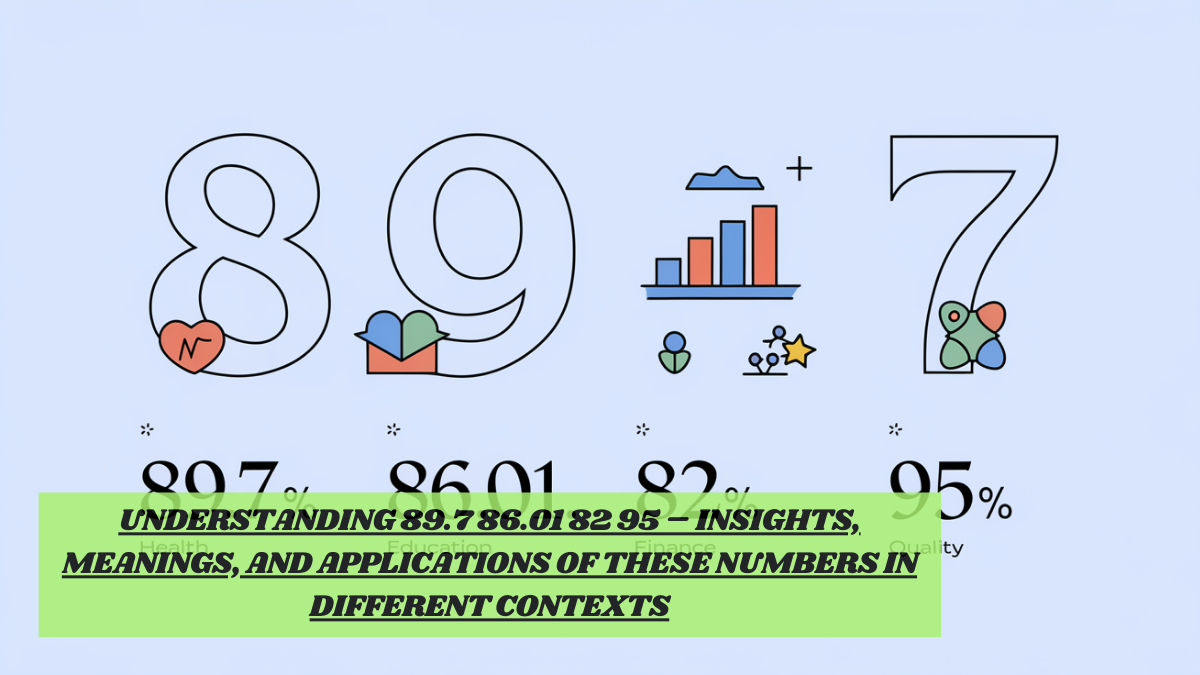Understanding 89.7 86.01 82 95 – Insights, Meanings, and Applications of These Numbers in Different Contexts
Introduction
Numbers play a crucial role in our daily lives, reflecting performance, quality, measurements, and ratings. The series “89.7 86.01 82 95” can represent values in various contexts, such as educational scores, health measurements, quality assessments, or financial data.
The sequence “89.7 86.01 82 95” often represents measurements, ratings, or scores across various fields, highlighting trends, performance levels, or quality standards in key applications.
In this article, we’ll dive deep into what these numbers signify and explore the common scenarios in which they might be applied. By the end, you’ll have a clear understanding of how to interpret these figures, what they could represent, and why they are meaningful.
1. What is “89.7 86.01 82 95”?
The sequence “89.7 86.01 82 95” consists of four numerical values that can have distinct meanings depending on their context. These numbers are often representative of scores, performance levels, or quality ratings in areas like education, health, consumer products, and finance.
2. Potential Contexts of These Numbers
Understanding the context is key to interpreting any set of numbers. Here are some of the most common areas where numbers like “89.7 86.01 82 95” might be applicable:
- Education: Used as grading metrics or test scores to measure academic performance.
- Health and Fitness: Represent physical measurements, fitness levels, or health scores.
- Product Quality: Ratings or scores to denote product durability, safety, or satisfaction.
- Finance: Reflect stock performance, bond ratings, or other financial indicators.
Each of these contexts assigns a unique significance to these numbers. Let’s examine each in detail.
3. Educational Grading Scales
In educational settings, scores such as “89.7, 86.01, 82, 95” often indicate exam results or GPA values:
- 89.7: Could represent a grade just below an A, reflecting high performance but leaving room for improvement.
- 86.01: This score might fall within a B+ range, suggesting good but not exceptional performance.
- 82: Generally closer to a B- or C+, indicating a moderate level of understanding.
- 95: Usually an A or A+, signifying excellence in academic performance.
Interpreting these numbers as grades can give insights into a student’s learning curve, strengths, and areas needing focus.
4. Health and Fitness Metrics
In health and fitness contexts, these numbers can reflect personal health statistics or fitness assessments:
- 89.7: Could indicate resting heart rate or body temperature.
- 86.01: Possibly represents blood pressure or BMI in some systems.
- 82: This might refer to muscle mass percentage or recovery time in athletic training.
- 95: Often used as a target goal or peak performance metric.
Understanding these metrics can help individuals improve their health, track fitness progress, or adjust wellness goals.
5. Quality Ratings in Product Testing
Quality assurance and product testing frequently use numerical scales to rate performance:
- 89.7: High-quality products with some minor issues.
- 86.01: Satisfactory quality, though lacking certain premium features.
- 82: Represents acceptable quality but might fall short in durability or functionality.
- 95: Top-tier quality, reflecting superior craftsmanship and reliability.
Such ratings guide consumers and manufacturers in product selection and improvement.
6. Financial Indicators and Benchmarks
In finance, numbers can signify stock performance, bond ratings, or other economic metrics:
- 89.7: A strong-performing stock but not at its peak.
- 86.01: Stable but may indicate a decline or slow growth.
- 82: Represents a lower performance, suggesting high risk.
- 95: Indicates strong growth, often reflecting a recommended buy.
Investors use these values to inform buying, selling, and holding strategies.
7. Significance in Consumer Ratings
Consumer ratings for products or services use numbers to reflect satisfaction or quality:
- 89.7: Positive feedback with minor improvements needed.
- 86.01: Mostly satisfied customers but with noticeable issues.
- 82: Averages in satisfaction but likely with mixed reviews.
- 95: Excellent feedback, high recommendation levels.
Ratings provide valuable feedback for potential buyers and help businesses improve service quality.
8. Data Interpretation: Trends and Insights
Data interpretation is essential for understanding scores or metrics, especially when assessing trends. For instance:
- 89.7 to 95: An upward trend, indicating improvement or growth.
- 86.01 to 82: Decline, suggesting a need for further analysis.
Analyzing these trends helps decision-makers understand underlying factors and take appropriate actions.
9. The Influence of Scores and Ratings on Decision-Making
Scores and ratings like “89.7 86.01 82 95” have a substantial impact on consumer behavior, healthcare strategies, and educational planning. High scores often lead to increased confidence and investment, while lower ratings might prompt caution or additional research. Understanding the weight and implications of each score supports better decision-making across multiple fields.
10. FAQs
Q1. What is the significance of the number sequence “89.7 86.01 82 95”?
A1. These numbers commonly represent performance, quality, or assessment metrics in fields like education, health, finance, and product testing.
Q2. How can “89.7 86.01 82 95” be used in education?
A2. These numbers might represent grading scales or test scores that show different levels of academic achievement.
Q3. Can these numbers be useful in health metrics?
A3. Yes, they can reflect vital signs or fitness assessments that help individuals monitor health goals.
Q4. What do these numbers mean in financial terms?
A4. In finance, such scores can indicate the stability, performance, or quality of stocks or bonds.
Q5. How do consumer ratings use “89.7 86.01 82 95”?
A5. Product reviews often use similar scores to rate quality and customer satisfaction.
Conclusion
Understanding the significance of numbers like “89.7 86.01 82 95” provides clarity across a range of disciplines. These numbers are versatile, used as benchmarks in education, health, finance, and consumer products. By recognizing what each value represents in its specific context, individuals and organizations can make informed decisions, set realistic goals, and track progress effectively.






